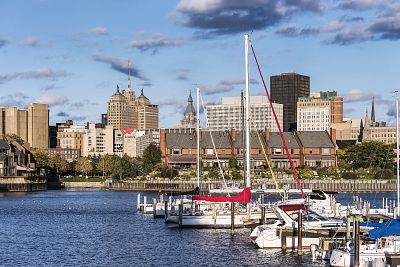"People tuned in to climate change are asking the question, 'Where is it safe to live in the long term?'" one climate scientist said.
Maria del Mar Agosto's house in San Juan, Puerto Rico, was destroyed on Sept. 20, 2017, by Hurricane Maria, setting off a series of events that would lead her to an unlikely new home just two months later: Buffalo, New York.
The city, with its 93.4 feet of average annual snowfall, does not come off as a likely landing spot for people like Agosto, who have been displaced by extreme weather. But her journey could become far more common as strong storms fueled by climate change displace more people.
"I prefer snow a thousand times than a hurricane," Agosto, 33, said in Spanish. "I truly feel safer here."
Buffalo, it turns out, might end up being the ideal destination for Agosto. The city isn't immune to climate change, but scientists say it's among a handful of cities that could become more desirable as the Earth warms.
While Agosto did not mean to be ahead of the curve, some forward-thinking people have looked to Buffalo as a snowy oasis. Susan Drayton moved to Buffalo from Florida in 2003, in part, because of what she calls her "apocalyptic vision" of the momentum of environmental problems after having lived through some extreme weather.
"I remember feeling all that anxiety about the weather," she said. "One thing about living in Buffalo, I don't have that same anxiety in the back of my mind."
Buffalo is one of a narrow band of northern U.S. cities that may be best positioned to withstand climate change, said Jesse M. Keenan, a professor at Harvard University's Graduate School of Design and an expert on climate change adaptation.
Keenan listed off what makes these cities so appealing: access to bodies of fresh lake water, distance from the coast, elevation from sea level, and colder weather that will become a little more temperate.
"If you're a Duluth, Minn., or a Buffalo or a Burlington, Vermont, there's an opportunity," he said. "You have a potentially superior place to live in the face of climate change."
Stephen Vermette, a professor of geography at SUNY Buffalo State, used climate data from 1965 to 2018 to analyze the impact of changing temperatures in Western New York. The models showed rising regional air temperatures and longer growing seasons. More surprising, however, was the discovery that severe weather indices, precipitation and extreme heat were largely unchanged over those years.
Many places — and people — will not be as fortunate. The Internal Displacement Monitoring Centre, an international organization based in Geneva, Switzerland, that tracks refugees, estimated that 16.1 million people were displaced in weather-related disasters across the planet in 2018. On Tuesday, the United Nations High Commissioner for Refugees warned that the world needs to prepare for millions of people who will be displaced by climate-related disasters and environmental changes.
Americans are also at risk. A study published in Nature three years ago projected that as many as 13.1 million Americans would be displaced from coastal areas by the end of this century because of rising sea levels.
Buffalo city officials have taken notice of these predictions. Brendan Mehaffy, executive director of Buffalo's Office of Strategic Planning, said the city can handle a climate-spurred influx of people.
"Our city was built with an infrastructure 30, 40 years ago that our population would be much larger than it is today," Mehaffy said. "So in terms of an initial absorption, it should not really be an issue."
Mehaffy stressed that there is no official campaign to woo people or businesses by "taking advantage of the misfortune of other places," but said corporate executives have mentioned such concerns to him in conversation at conferences. In his most recent state of the city speech in February, Mayor Byron Brown declared that Buffalo would be a "climate change refuge" and announced more sustainable energy initiatives to prepare for the future.
Ben Strauss, CEO and chief scientist of the research organization Climate Central, said livable locations are an emerging topic in climate circles.
"People tuned in to climate change are asking the question, 'Where is it safe to live in the long term?'" he said. "Look at California, it was supposed to be paradise but climate change is making the wildfires worse, and that picture of paradise is changing."
Agosto, who married her boyfriend last year in her new home, said she is acclimating to the city. She started working at a job in a factory and has taken in a family of Puerto Ricans left homeless by the recent earthquakes on the island.
And she's getting used to the cold.
"When I come home, I always turn the heater on," she said.













